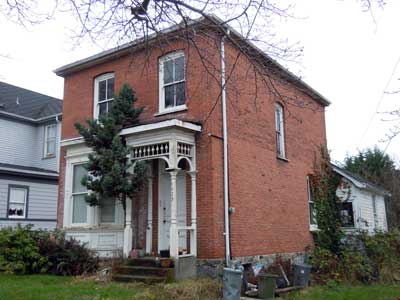ARCHITECTURE:
This house is a hip-roofed, two-storey brick cubical Italianate. The windows on the upper front and right side have segmental arches. The angled bay on the lower left front has applied moulding on the casings. The porch on the right has square turned posts, turned spindles in the frieze; it is missing its turned balusters in the balustrade. Both the bay and porch have flat roofs with moulding and panels below. There is a gabled wooden addition at the rear with an incongruous Queen Anne stained glass window. The house was duplexed in 1956.
ORIGINAL OCCUPANTS:
1891-92: Robinson and Wilmot were both listed on assessments. George Wilmot was a blacksmith for carriage makers Fisher & Christie in 1892 and he is listed as living on the street from 1893-95.
1893-96: John and Agnes Robinson were born in England, and lived in Quebec before coming to Victoria. John was a stone mason, but built a brick house because stone was too expensive as a building material in Victoria.
OTHER OCCUPANTS:
1899-1904: Blacksmith, dairyman, butcher and farmer Edward Simpson (1864-1948) and Ellen (Helen) “Nellie” (née Wain, 1866-1953). In 1910-11 Edward and Nellie lived in Oak Bay and he worked for the Vancouver Island Coal Co.
[Note: Edward was born in Saanich to Henry and Adelaide Simpson, who married in their native Essex, England, in July 1852 before sailing to Canada. They arrived at Fort Victoria in January 1853 on the third voyage of the Norman Morison. They both worked for the HBC, Adelaide as a laundress and Henry as an agricultural labourer on Constance Cove Farm in Esquimalt, where the first three of their 10 children were born. By 1859 they had enough money to buy land. They established one of the first farms in South Saanich (now Central Saanich). Several years later they built the Prairie Tavern, then the Prairie Inn [still standing] in 1893. In 1864 Henry became one of the first two landowners in Victoria West (see Victoria West History), but quickly sold that land to buy more in Central Saanich. Henry Simpson was a founding member of the North & South Saanich Agricultural Society, originated the Norfolk breed of sheep on Vancouver Island, ran a stage coach between Victoria and Saanichton, had a hack horse service, and was a road contractor and postmaster.]
[Note: Nellie was born in North Saanich, the daughter of Henry and Sarah Wain from Kent, England. Henry Wain has the distinction of arriving at Fort Victoria on both the 1st and 2nd voyages of the Norman Morison, in 1850 and 1851, as he went back to England in between. On his third trip back to England, he married Sarah. Henry Wain was a skilled finishing carpenter: he built the windows on Craigflower Schoolhouse and a mill for the HBC. After HBC released him from his indenture, he set up his own business. Victoria’s first mayor, butcher Thomas Harris, had Henry build him a barn in North Saanich. Henry liked the district so bought his own 160 acres nearby, by the west corner of the road later named for him. He was a pioneer hop grower, ran a tavern, the first North Saanich post office, and a stage.
1907-09: Nellie’s brother William Thomas Wain (1871-1964) married Edward’s sister Adelaide Simpson (1874-1958) and they plumbed this house in 1907. From 1908-11, William worked for E.G. Prior & Co as a clerk, warehouseman and salesman.
1905-06: Between the Simpsons and the Wains, the residents were Charles Dundas and Annie Margaret Ure, who married in Victoria in 1893. At the time of their marriage, Charles was a shoemaker and Annie, a dressmaker. [Note: Both were born in Victoria to Scottish, Irish and English immigrants who all came in the early 1860s. Charles’s father James Ure was a carpenter and seafarer, but became the manager of Christopher Morley’s Soda Works in Waddington Alley; Annie’s father Michael Roarke was a tobacconist, then for many years employed at Victoria Gas Co (502 Pembroke St, Burnside).] From 1902 until his death, Charles was a driver for Morley’s Soda Works.
1910-11: Carpenter and home builder Clarence and Rosina Hugill, who came from England in 1910. They then moved to the state of Washington.
1912-15: Spencer’s department store employee John R. Anderson.
1918: Plumber’s helper John Paynter and his offspring Ruth, a steno, and Wesley Thomas, an auto mechanic, then a heavy duty operator for many years.

